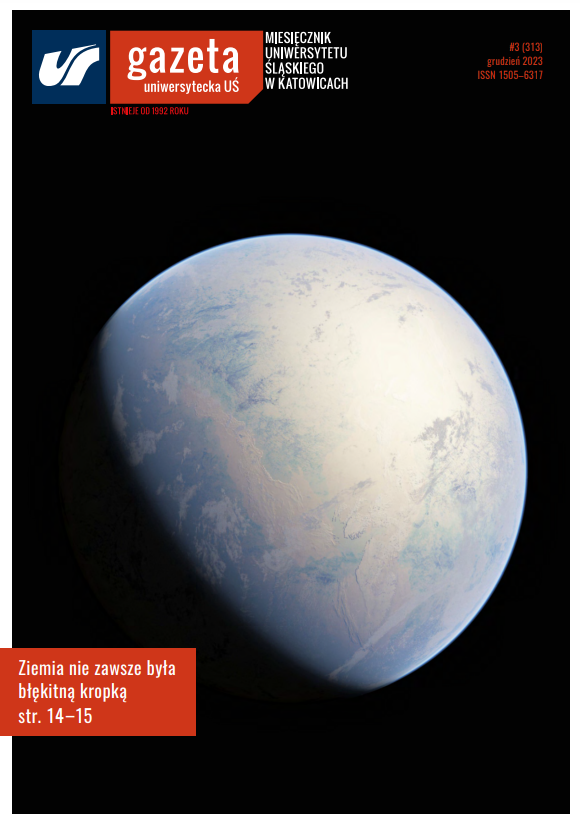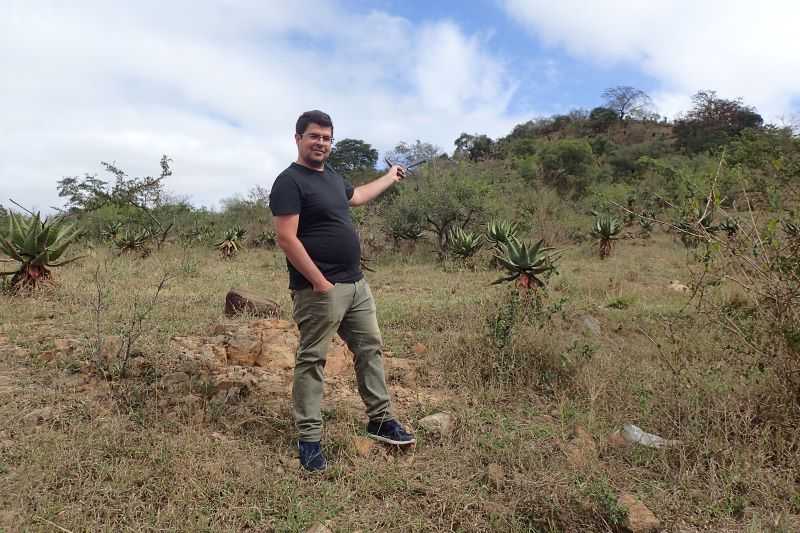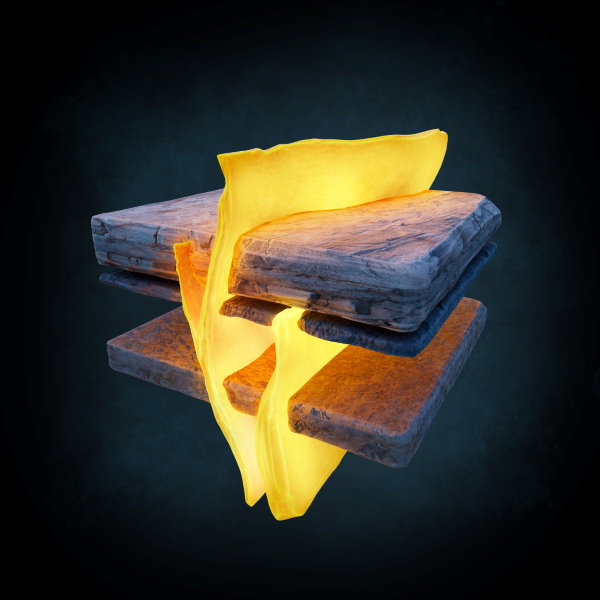| Weronika Cygan |
Imagine that the entire surface of Europe or North America is covered by lava constantly pouring out of the depths of the Earth. We are not sure whether it escapes during a simultaneous eruption of many volcanoes or whether it slowly seeps to the Earth’s surface, but we do know that this process takes up to 10 million years at most. Such phenomena have occurred on our planet many times, transforming it considerably. They will certainly happen again, although it is doubtful that Homo sapiens will still be alive at that time. The so-called large igneous provinces (LIPs), or rather what’s left of them, are being studied by Ashley Gumsley, PhD from the Institute of Earth Sciences at the University of Silesia in Katowice, Poland.
The pale blue dot we live on has not always been a life-friendly place. The Earth has repeatedly made it difficult to thrive for the organisms living on it, sometimes leading to their near-complete extinction. We can blame the vast majority of mass extinctions on the activity of our planet. The end of the dinosaur age 66 million years ago, as well as by an asteroid impact, might have been brought about by the Deccan traps, which appeared at that time in India and were formed in a series of successive LIPs, the aforementioned large lava cap formation processes.
Ashley Gumsley PhD pointing to the dike | private archive
“The Cretaceous extinction wiped out nearly 75% of living organisms. Meanwhile, the extinction at the end of the Permian, about 252 million years ago, had been much worse, with almost 83% of life disappearing. This is suspected to have been caused by the Siberian traps and therefore the LIPs, which covered almost the entire area of Siberia. In the latter case, lava flowing into the ocean seems to have poisoned the water, changing its chemistry to the point where it was extremely difficult for marine organisms to function” explains the geologist.
Great cold after great heat
Terrestrial life at the first stage of the great lava cap formations was threatened by poisonous gases or vapours accompanying the lava flows. Another danger was the sudden drop in temperature that occurred shortly afterwards. It was this shift which, to a much greater extent and for a much longer period, caused a drastic refurbishment of the natural order of our planet.
The emissions of gases and dust into the atmosphere changed the climate in several ways. Initially, they obscured sunlight, resulting in a so-called volcanic winter. The sudden cooling of the environment affected the organisms around the globe – many of them could not survive such a rapid change in conditions. In the next stage, however, a real test of endurance awaited them.
That last instance of large lava sheet formation, occurred about 20-30 million years ago in what is now North America, but it did not trigger a global glaciation. The huge volumes of lava that came to the surface at that time began to cool at some point, taking the form of hard rocks that were subject to weathering processes that involved them capturing and binding significant amounts of carbon dioxide from the atmosphere. At this stage, the cooling of the climate accelerated. In the history of our planet, there have been times when almost all of it was covered in ice and snow – the so-called ‘Snowball Earth’ significantly hindered evolution and was scarcely able to support life.
A journey inside the Earth
In his research, Ashley Gumsley, PhD primarily focuses on Precambrian LIPs (older than 540 million years). He aims to explore the conditions on our planet millions of years ago, and what the geological layers tell us about them.
“I am working on parts of the Earth’s crust that are very old and stable, and such parts can only be found in a handful of places. First, I have to select an area that seems particularly promising. Among other things, I search Google Earth images, scanning for dikes.” explains the scientist.
Dikes are magma intrusions, incompatible with the arrangement of older rock layers. They were the means by which, millions of years ago, lava made its way from the planet’s interior to the surface. They can be seen on satellite images – they stretch for hundreds or, as in Canada, a thousand kilometres. They stand out from other rock layers because of their dark colour, although rarely are they as easy to spot as in the 3 billion-year-old East Australian Pilbara craton.
“In South Africa, within the Kaapvaal craton, the dikes are not very well exposed on the surface, as they are covered by a thick layer of soil. That is where river activity helps, as the cutting of river channels into the bedrock creates natural rock exposures. In such places, along rivers, dikes can be easily identified by their distinctive colour and shape” explains Ashley Gumsley, PhD.
Sometimes it is difficult to assess the age of a particular rock, especially when many different dike systems intrude into the old pluton. Then it is only possible to say that the dikes are younger than the rocks they intersect. Chemists and physicists come to the rescue. The former can tell you something about the chemical composition – the dikes carry information from the Earth’s mantle from which their material originates. Physicists, on the other hand, look for clues about the orientation relative to the magnetic field. When magma rock cools, minerals are formed – and these minerals retain a record of the Earth’s magnetic field from the time of their formation.
Challenges of a geologist
Thanks to the efforts of Ashley Gumsley, PhD, the Faculty of Natural Sciences in Sosnowiec has been able to upgrade the rock preparation laboratory where the first stage of LIP research is possible.
“Here I can crush the rock and separate the minerals for dating. However, I cannot carry out the actual isotopic analysis here. Although we have analytical equipment suitable for this in Poland, it is not used nor calibrated for my type of research” says the researcher, who works closely with the Natural History Museum in Stockholm.
“What I deal with cannot be studied in Poland because I study a very specific mineral – baddeleyite (ZrO2). Only a few people in the world are able to conduct such a research. The main problem is the separation of this mineral. My previous supervisor in Sweden, Prof Ulf Söderlund, developed a method that makes this process simpler, and I implemented it in the MAGIC laboratory I built at the University of Silesia,” explains Ashley Gumsley, PhD, adding that currently only two laboratories in the world use this method.
Once the mineral is separated, it is used for dating, which in the case of the work carried out by the geologist still poses some difficulties. Of the five laboratories in the world that can cope with this task, the closest one is located in Stockholm. However, the scientist is trying to get the right equipment for the department in Sosnowiec. This would significantly reduce research costs and save valuable time.
Polish perspectives
“I visited Poland for the first time in 2018. One of the reasons why I was so keen to come here was that a lot of importance is placed on basic research in this country. There is also a different atmosphere here than in the West, where European and American scientists compete strongly with each other. They are also convinced that everything they do should represent a rapid breakthrough in scientific discovery and have a direct impact on society. Unfortunately, not everything can be like that. In science, we have both breakthroughs and grass-roots work, which often leads to breakthroughs” says Ashley Gumsley, PhD.
The scientist is currently working on two projects within the framework of competitions of the National Science Centre – OPUS and SONATINA. In the first case, the geologist’s work is related to LIPs and global glaciations. The second project concerns the use of several different minerals found in the dikes to test the extent to which magnetic information behaves in large lava sheets.
The geologist does not stop at field and laboratory work. He is also keen to get involved in science communication. During the Geo Picnic – an event periodically held at the Faculty of Natural Sciences in Sosnowiec – he organised a gold panning game for participants.
Article titled “The Earth was not always a blue dot” was published in the December issue of “USil Magazine” No. 3 (313).








